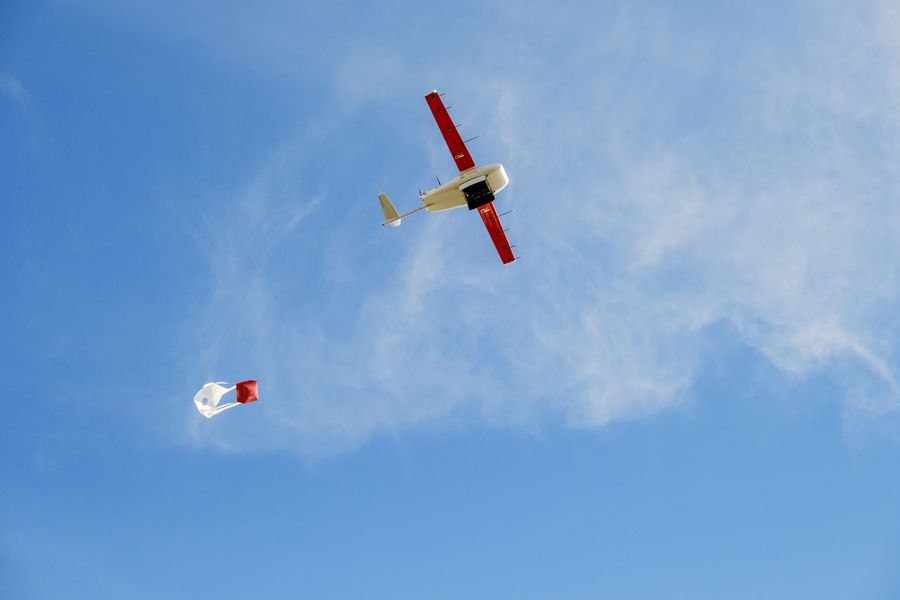
Leading global instant logistics company Zipline has passed another major milestone in its operational evolution – and in the future scaling of the entire drone delivery sector – by obtaining authorization from the Federal Aviation Administration (FAA) to operate beyond visual line of sight (BVLOS) flights.
The FAA decision announced late Monday allows Zipline “to deliver commercial packages” under its previously granted Part 135 airline operator certification, adding the additional exemption of “using drones that fly beyond the operator’s visual line of sight.” The South San Francisco-based startup had been eagerly awaiting the administrator’s ruling in the wake of earlier BVLOS exemptions granted to Avionix, Airobotics, and UPS Flight Forward earlier this month.
The FAA exemption to operate BVLOS flights stipulated its application to geographical areas “around Salt Lake City and Bentonville, Arkansas.” Zipline operates drone delivery services for Walmart in the first location, and is expanding similar services for healthcare and medical clients in the second.
Zipline officials had been eagerly awaiting the decision as key to the company shaking off what has been a major scaling hinderance for all drone delivery operators: the obligation for a human observer to maintain direct eye contact with craft while in flight.
The flexibility obtained by the FAA exemption, meanwhile, is also necessary for Zipline to fully leverage the new Platform 2 aerial delivery system it unveiled in March, and plans to bring it online in coming months.
Built around paired drone transport and droid delivery craft, automated package loading mechanisms installed in customer facilities, and networks of recharging nests freeing UAVs from home-destination-home operation to instead respond to the nearest client order, the underlying flexible, fast-moving concept can only reach maximum functionality with drones operating longer distance BVLOS routes.
The same is generally true to allow sector-wide drone delivery and other UAV services to fully take wing, say Zipline CEO Keller Rinaudo Cliffton. Additional FAA BVLOS authorizations, he suggests, represent the key to unlocking the faster, cheaper, and environmentally cleaner aerial reconfiguration of the entire US supply chain system.
“Today we use 4,000-pound gas combustion vehicles driven by humans to do billions of deliveries across the country… (which is) expensive, slow, and bad for the environment,” said Rinaudo Cliffton in reacting to the FAA’s BVLOS exemption. “This decision means that we can start to transition delivery to solutions that are 10x as fast, less expensive, and zero emission. It means that Zipline hubs across the country can now go from serving a few thousand homes to serving hundreds of thousands of homes each year and millions of people, which will save time, money, and even lives.”
For now, however, Monday’s FAA ruling will apply only to Sparrow drones operating under Zipline’s initial Platform 1, which uses a parachute to drop goods to their final destination.
Yet recent history suggests that once a company has received an initial FAA waiver, obtaining additional authorizations becomes comparatively easier. That raises the potential of Zipline being able to eventually secure BVLOS authorizations of its P2 network as well, and gradually creating a daisy-chain wider networks using those – awaiting a full exemption covering the entire US.
The freedom and range afforded in those scenarios would be similar to those the company has benefitted from in other nations around the globe, particularly in its booming drone delivery work in Africa. All told, Zipline has racked up 50 million commercial autonomous miles and completed more than 750,000 commercial deliveries worldwide – all, it says, without a single major safety incident.
According to Zipline’s head of global aviation regulatory affairs Okeoma Moronu, that record of secure, accident-free drone delivery activity was a major factor in the FAA’s BVLOS exemption for its first US markets.
“The FAA has incredibly high safety standards and it’s a testament to the entire Zipline team that our delivery drones are entrusted to fly and deliver at scale, over populated areas, in the most complex airspace in the world,” Moronu said. “We applaud the FAA for taking a major step to integrate autonomous drone delivery into the airspace. This will enable more commerce, new economic opportunities, and greater access for millions of Americans.”
FTC: We use income earning auto affiliate links. More.



Comments